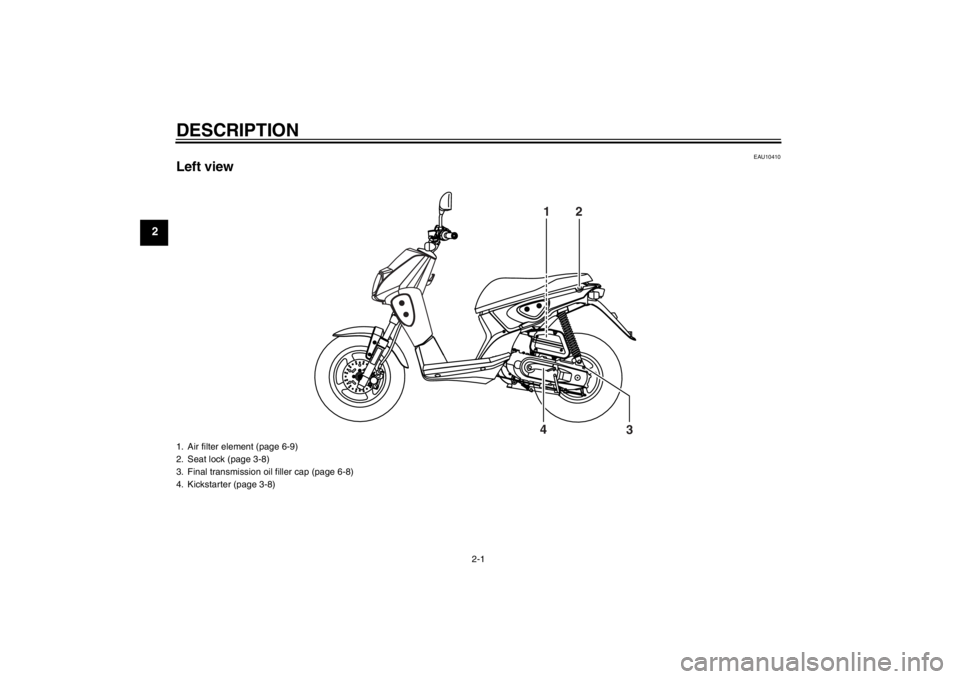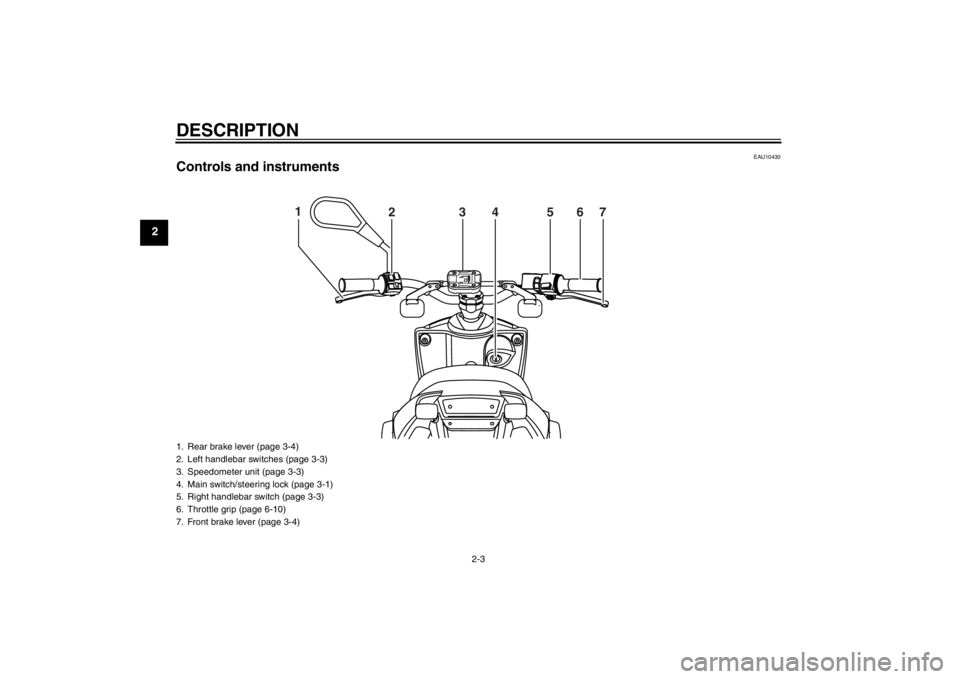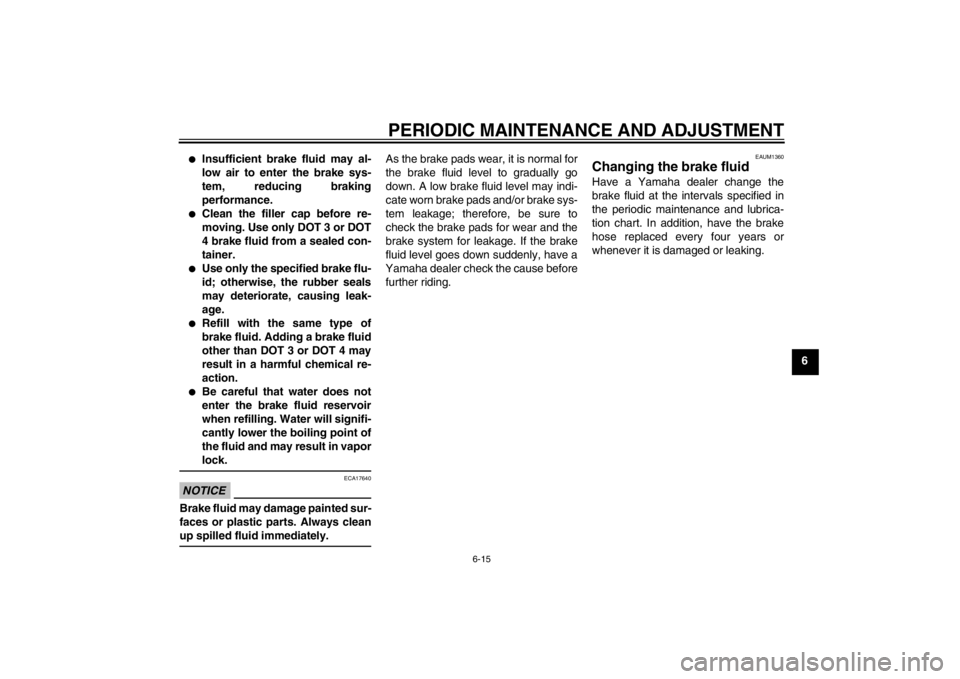2013 YAMAHA SLIDER 50 lock
[x] Cancel search: lockPage 6 of 66

TABLE OF CONTENTSSAFETY INFORMATION ..................1-1
Further safe-riding points ................1-5
DESCRIPTION ..................................2-1
Left view ..........................................2-1
Right view ........................................2-2
Controls and instruments.................2-3
INSTRUMENT AND CONTROL
FUNCTIONS.......................................3-1
Main switch/steering lock ................3-1
Indicator lights and warning light ....3-2
Speedometer unit ...........................3-3
Handlebar switches ........................3-3
Front brake lever ............................3-4
Rear brake lever .............................3-4
Fuel and 2-stroke engine oil tank
caps .............................................3-5
Fuel .................................................3-5
Catalytic converter ..........................3-6
2-stroke engine oil ..........................3-7
Starter (choke) lever .......................3-7
Kickstarter .......................................3-8
Seat ................................................3-8
Anti-theft device housing ................3-8
Luggage hook .................................3-9FOR YOUR SAFETY –
PRE-OPERATION CHECKS............. 4-1
OPERATION AND IMPORTANT
RIDING POINTS................................. 5-1
Starting a cold engine .................... 5-1
Starting a warm engine .................. 5-2
Starting off ...................................... 5-2
Acceleration and deceleration ........ 5-3
Braking ........................................... 5-3
Tips for reducing fuel
consumption ............................... 5-4
Engine break-in .............................. 5-4
Parking ........................................... 5-5
PERIODIC MAINTENANCE AND
ADJUSTMENT................................... 6-1
Periodic maintenance chart for the
emission control system ............. 6-2
General maintenance and
lubrication chart .......................... 6-3
Removing and installing the cowling
and panel .................................... 6-6
Checking the spark plug ................. 6-7
Final transmission oil ...................... 6-8
Cleaning the air filter element ........ 6-9
Adjusting the carburetor ............... 6-10
Checking the throttle grip free
play ........................................... 6-10
Tires ............................................. 6-10
Cast wheels .................................. 6-12Checking the front brake lever free
play ........................................... 6-13
Adjusting the rear brake lever free
play ........................................... 6-13
Checking the front brake pads and
rear brake shoes ...................... 6-14
Checking the brake fluid level ...... 6-14
Changing the brake fluid .............. 6-15
Checking and lubricating the
cables ....................................... 6-16
Checking and lubricating the
throttle grip and cable ............... 6-16
Lubricating the front and rear
brake levers .............................. 6-16
Checking and lubricating the
centerstand ............................... 6-17
Checking the front fork ................. 6-18
Checking the steering .................. 6-18
Checking the wheel bearings ....... 6-19
Battery ......................................... 6-19
Replacing the fuse ....................... 6-21
Replacing the headlight bulb ....... 6-21
Replacing the tail/brake light
bulb ........................................... 6-22
Replacing a turn signal light
bulb ........................................... 6-22
Troubleshooting ........................... 6-23
Troubleshooting chart .................. 6-24
SCOOTER CARE AND STORAGE... 7-1
Matte color caution ........................ 7-1U1S0E1E0.book Page 1 Wednesday, November 7, 2012 3:32 PM
Page 14 of 66

DESCRIPTION
2-1
2
EAU10410
Left view
12
3 4
1. Air filter element (page 6-9)
2. Seat lock (page 3-8)
3. Final transmission oil filler cap (page 6-8)
4. Kickstarter (page 3-8)U1S0E1E0.book Page 1 Wednesday, November 7, 2012 3:32 PM
Page 16 of 66

DESCRIPTION
2-3
2
EAU10430
Controls and instruments
1
234567
1. Rear brake lever (page 3-4)
2. Left handlebar switches (page 3-3)
3. Speedometer unit (page 3-3)
4. Main switch/steering lock (page 3-1)
5. Right handlebar switch (page 3-3)
6. Throttle grip (page 6-10)
7. Front brake lever (page 3-4)U1S0E1E0.book Page 3 Wednesday, November 7, 2012 3:32 PM
Page 17 of 66

INSTRUMENT AND CONTROL FUNCTIONS
3-1
3
EAU10461
Main switch/steering lock The main switch/steering lock controls
the ignition and lighting systems, and is
used to lock the steering. The various
positions are described below.
EAU10640
ON “ ”
All electrical circuits are supplied with
power, and the engine can be started.
The key cannot be removed.TIPThe headlight, meter lighting and tail-
light come on automatically when the
engine is started.
EAU10661
OFF “ ”
All electrical systems are off. The key
can be removed.
WARNING
EWA10061
Never turn the key to “ ” or “ ”
while the vehicle is moving. Other-
wise the electrical systems will be
switched off, which may result in
loss of control or an accident.
EAUM2920
CHECK “ ”
The 2-stroke engine oil level warning
light and the fuel level warning light
should come on. (See page 3-2.)
EAU10684
LOCK “ ”
The steering is locked, and all electrical
systems are off. The key can be re-
moved.
To lock the steering1. Turn the handlebars all the way to
the left.
2. Push the key in from the “ ” posi-
tion, and then turn it to “ ” while
still pushing it.3. Remove the key.
To unlock the steering
Push the key in, and then turn it to “ ”
while still pushing it.
P
U
S
H
ZAUM0332
U1S0E1E0.book Page 1 Wednesday, November 7, 2012 3:32 PM
Page 21 of 66

INSTRUMENT AND CONTROL FUNCTIONS
3-5
3
EAU13202
Fuel and 2-stroke engine oil
tank caps The fuel tank cap and the 2-stroke en-
gine oil tank cap are located under the
seat. (See page 3-8.)
Fuel tank cap
To remove the fuel tank cap, turn it
counterclockwise, and then pull it off.
To install the fuel tank cap, turn it clock-
wise.
2-stroke engine oil tank cap
To remove the 2-stroke engine oil tank
cap, pull it off.To install the 2-stroke engine oil tank
cap, push it into the oil tank opening.
WARNING
EWA10141
Make sure that the fuel and 2-stroke
engine oil tank caps are properly in-
stalled before riding the scooter.
Leaking fuel is a fire hazard.
EAU13212
Fuel Make sure there is sufficient gasoline in
the tank.
WARNING
EWA10881
Gasoline and gasoline vapors are
extremely flammable. To avoid fires
and explosions and to reduce the
risk of injury when refueling, follow
these instructions.1. Before refueling, turn off the en-
gine and be sure that no one is sit-
ting on the vehicle. Never refuel
while smoking, or while in the vi-
cinity of sparks, open flames, or
other sources of ignition such as
the pilot lights of water heaters and
clothes dryers.
2. Do not overfill the fuel tank. Stop
filling when the fuel reaches the
bottom of the filler tube. Because
fuel expands when it heats up,
heat from the engine or the sun
can cause fuel to spill out of the
fuel tank.
1. Fuel tank cap
2. 2-stroke engine oil tank cap
2 1
ZAUM0144
U1S0E1E0.book Page 5 Wednesday, November 7, 2012 3:32 PM
Page 24 of 66

INSTRUMENT AND CONTROL FUNCTIONS
3-8
3
EAUS1050
Kickstarter To start the engine, push the kickstarter
down lightly with your foot until the
gears engage, and then push it down
smoothly but forcefully.
EAU13891
Seat To open the seat
1. Insert the key in the lock, and then
turn it as shown.
2. Fold the seat up.
To close the seat
1. Fold the seat down, and then push
it down to lock it in place.
2. Remove the key.TIPMake sure that the seat is properly se-
cured before riding.
EAUM1580
Anti-theft device housing The anti-theft device housing, located
under the seat, is designed to store a
joint type anti-theft device with a maxi-
mum length of 1 meter. (See page 3-8
for seat opening and closing proce-
dures.)TIPSome anti-theft devices cannot fit into
the housing due to their size or shape.
1. Kickstarter
1
ZAUM0146
1. Seat
2. Seat lock
1
2
ZAUM0147
1. Anti-theft device housing
1
ZAUM0148
U1S0E1E0.book Page 8 Wednesday, November 7, 2012 3:32 PM
Page 47 of 66

PERIODIC MAINTENANCE AND ADJUSTMENT
6-15
6
●
Insufficient brake fluid may al-
low air to enter the brake sys-
tem, reducing braking
performance.
●
Clean the filler cap before re-
moving. Use only DOT 3 or DOT
4 brake fluid from a sealed con-
tainer.
●
Use only the specified brake flu-
id; otherwise, the rubber seals
may deteriorate, causing leak-
age.
●
Refill with the same type of
brake fluid. Adding a brake fluid
other than DOT 3 or DOT 4 may
result in a harmful chemical re-
action.
●
Be careful that water does not
enter the brake fluid reservoir
when refilling. Water will signifi-
cantly lower the boiling point of
the fluid and may result in vapor
lock.
NOTICE
ECA17640
Brake fluid may damage painted sur-
faces or plastic parts. Always clean
up spilled fluid immediately.
As the brake pads wear, it is normal for
the brake fluid level to gradually go
down. A low brake fluid level may indi-
cate worn brake pads and/or brake sys-
tem leakage; therefore, be sure to
check the brake pads for wear and the
brake system for leakage. If the brake
fluid level goes down suddenly, have a
Yamaha dealer check the cause before
further riding.
EAUM1360
Changing the brake fluid Have a Yamaha dealer change the
brake fluid at the intervals specified in
the periodic maintenance and lubrica-
tion chart. In addition, have the brake
hose replaced every four years or
whenever it is damaged or leaking.
U1S0E1E0.book Page 15 Wednesday, November 7, 2012 3:32 PM
Page 53 of 66

PERIODIC MAINTENANCE AND ADJUSTMENT
6-21
6
EAU23503
Replacing the fuse The fuse holder is located behind panel
A. (See page 6-6.)
If the fuse is blown, replace it as fol-
lows.
1. Turn the key to “ ” and turn off all
electrical circuits.
2. Remove the blown fuse, and then
install a new fuse of the specified
amperage. WARNING! Do not
use a fuse of a higher amperage
rating than recommended to
avoid causing extensive dam-
age to the electrical system and
possibly a fire.
[EWA15131]
3. Turn the key to “ ” and turn on
the electrical circuits to check if the
devices operate.
4. If the fuse immediately blows
again, have a Yamaha dealer
check the electrical system.
EAUM2111
Replacing the headlight bulb If the headlight bulb burns out, replace
it as follows.NOTICE
ECA10670
It is advisable to have a Yamaha
dealer perform this job.1. Remove cowling A. (See page
6-6.)
2. Disconnect the headlight coupler.
3. Remove the headlight bulb holder
by turning it counterclockwise, and
then remove the burnt out bulb.
4. Place a new headlight bulb into po-
sition, and then secure it with the
bulb holder.
5. Connect the coupler.
1. Panel A
2. Fuse
3. Battery
32 1
ZAUM0162
Specified fuse:
7.5 A
1. Headlight bulb holder
1
ZAUM0899
U1S0E1E0.book Page 21 Wednesday, November 7, 2012 3:32 PM